Components
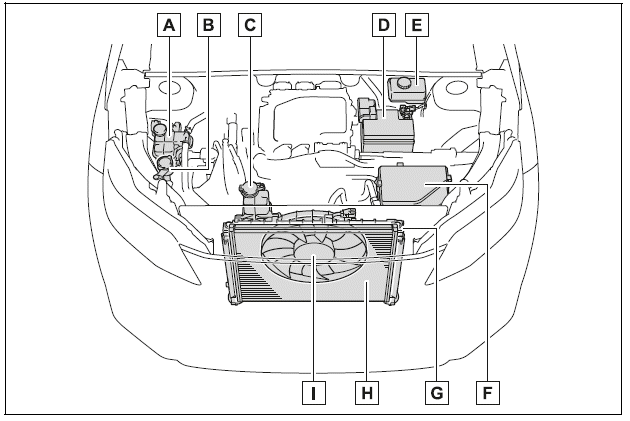
Checking the heater coolant
The coolant level is satisfactory if it is between the "MAX" and "MIN" lines on the reservoir when the EV system is cold.

If the level is on or below the "MIN" line, add coolant up to the "MAX" line.
Coolant and Cooling System Maintenance
Coolant Selection
For optimal performance and protection of your engine, always use a high-quality, ethylene glycol–based coolant that meets the required specifications. Only use "Toyota Super Long Life Coolant" or a comparable product that is non-silicate, non-amine, non-nitrite, and non-borate, incorporating long-life hybrid organic acid technology. This premium coolant is pre-mixed with 50% coolant and 50% deionized water, offering excellent freeze protection down to approximately -35ºC (-31ºF). For further details on the appropriate coolant, please consult your Toyota dealer.
If the Coolant Level Drops Shortly After Replenishing
When you notice that the coolant level falls rapidly after topping up, it is crucial to perform a visual inspection of the radiator, hoses, coolant reservoir caps on the power control unit, drain cock, and water pump. If no obvious leak appears, have your Toyota dealer conduct a more thorough evaluation, including testing the cap and checking for hidden leaks within the cooling system.
WARNING
When the Heater System is Hot
Never remove the heater coolant reservoir caps while the heater system is hot. The system may be under pressure, and removing the cap can result in hot coolant spraying out, which could cause serious burns or injuries.
NOTICE
When Adding Coolant
It is important to understand that coolant is not merely plain water or straight antifreeze. The proper mixture of water and antifreeze must be used to provide effective lubrication, corrosion protection, and cooling. Always read the antifreeze or coolant label to ensure you are mixing the correct proportions.
If You Spill Coolant
Should you accidentally spill coolant, promptly wash the area with water. This immediate action helps prevent any potential damage to vehicle parts or paint.
Checking the Radiator and Condenser
Regular inspection of the radiator and condenser is essential. Remove any foreign objects that might block airflow, and if these parts appear heavily soiled or their condition is uncertain, have your vehicle inspected by a Toyota dealer.
WARNING
When the EV System is Hot
Do not touch the radiator or condenser when the EV system is operating at high temperatures. These components may be extremely hot and could cause severe burns upon contact.
When the Electric Cooling Fan is Operating
Refrain from touching the motor compartment while the electric cooling fan is active. With the power switch in the ON position-especially when the air conditioning is active or the coolant temperature is high-the cooling fan may automatically engage. Ensure that the power switch is OFF before performing any work near the electric fan or the radiator grille.
Adhering to proper coolant and cooling system maintenance protocols is critical for extending the life of your vehicle’s engine and avoiding costly repairs. Consistently using the correct coolant mixture protects against corrosion and freezing, while regular inspections ensure that any leaks or blockages are promptly addressed. For owners of the 2024 Toyota bZ4X, following these guidelines not only optimizes vehicle performance but also reinforces the reliability of its advanced systems.
Incorporating these maintenance practices into your routine care schedule will ensure that your cooling system remains efficient, providing the essential temperature regulation needed for safe and economical driving. Whether you are topping up the coolant or inspecting the radiator and condenser, every step you take contributes to a safer, more reliable driving experience. Always consult your vehicle’s service manual for detailed procedures and seek professional guidance when uncertainties arise.
Checking the power control unit coolant
The coolant level is satisfactory if it is between the "MAX" and "MIN" lines on the reservoir when the EV system is cold.
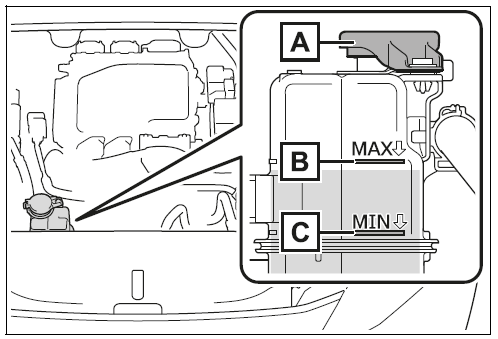
If the level is on or below the "MIN" line, add coolant up to the "MAX" line.
Checking fluid level
The brake fluid level should be between the "MAX" and "MIN" lines on the tank.
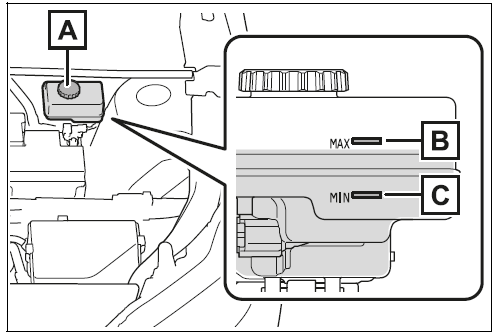
Checking the 12-volt battery
Check the 12-volt battery as follows
12-volt battery exterior
Make sure that the 12-volt battery terminals are not corroded and that there are no loose connections, cracks, or loose clamps.
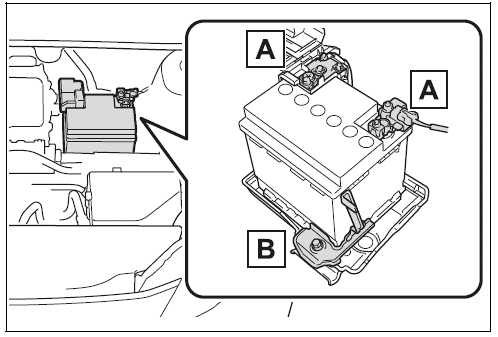
Checking 12-volt battery fluid
Check that the level is between the "UPPER LEVEL" and "LOWER LEVEL" lines.
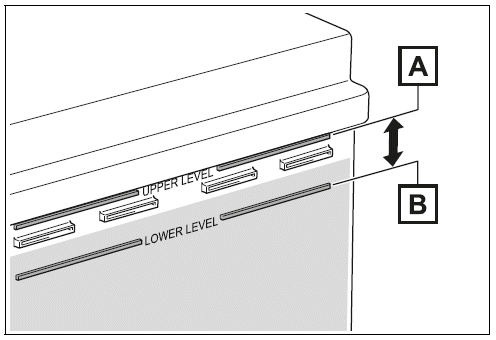
If the fluid level is at or below the "LOWER LEVEL" line, add distilled water.
Adding distilled water
If the "UPPER LEVEL" cannot be seen, check the fluid level by looklooking directly at the cell.
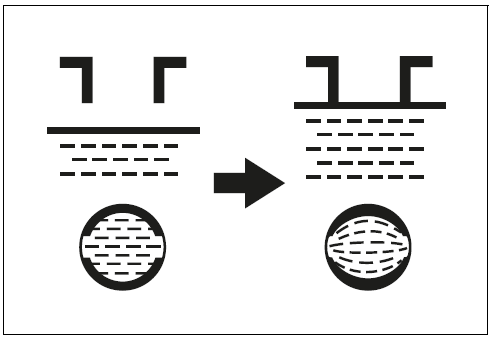
Before Recharging
When preparing to recharge your vehicle’s 12-volt battery, be aware that this process releases hydrogen gas-a flammable and explosive byproduct. To protect yourself and your vehicle, observe these precautions before beginning the recharging process:
After Recharging/Reconnecting the 12-Volt Battery
In some cases, the EV system may not automatically start after the battery has been recharged or reconnected. To initialize the system correctly, follow this procedure:
If the EV system fails to start even after multiple attempts, contact your Toyota dealer immediately.
WARNING
Chemicals in the 12-Volt Battery
Batteries contain poisonous, corrosive sulfuric acid and can emit hydrogen gas, which is both flammable and explosive. To minimize the risk of serious injury or fatality, follow these safety measures when working on or near the 12-volt battery:
Where to Safely Charge the 12-Volt Battery
Always recharge the 12-volt battery in an open, well-ventilated area. Never charge it in a closed garage or room where ventilation is insufficient.
Emergency Measures Regarding Electrolyte Exposure
When There is Insufficient 12-Volt Battery Fluid
Do not operate the battery if there is an insufficient level of fluid, as this poses a severe risk of explosion.
NOTICE
When Recharging the 12-Volt Battery
Never attempt to recharge the 12-volt battery while the EV system is operating. Additionally, ensure all vehicle accessories are turned off during the recharging process.
When Adding Distilled Water
Avoid overfilling the battery with distilled water during recharging. Excess water can spill and lead to corrosion, which may compromise battery performance.
Proper handling of the 12-volt battery is vital for both safety and vehicle performance. Following these detailed precautions reduces the risk not only of battery damage but also of hazardous reactions that can occur during recharging. For owners of the Toyota bZ4X, meticulous adherence to these guidelines ensures that the high-tech systems in your vehicle continue to operate safely and effectively. Always refer to your owner’s manual and consult with a professional if any uncertainties arise regarding battery maintenance or related procedures.
Regular maintenance incorporating these best practices helps safeguard your investment and enhances overall vehicle reliability. Remember: safety is paramount when dealing with any automotive battery work-take careful measures to avoid injury and preserve the integrity of your vehicle's electrical system.
Adding the washer fluid
If any washer does not work or the warning message appears on the multi-information display, the washer tank may be empty.
Add washer fluid.
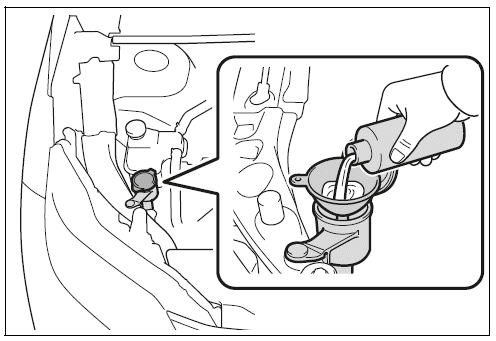
WARNING
When adding washer fluid
Do not add washer fluid when the EV system is hot or operating as washer fluid contains alcohol and may catch fire if spilled on the motor, etc.
NOTICE
Do not use any fluid other than washer fluid
Do not use soapy water or antifreeze instead of washer fluid.
Doing so may cause streaking on the vehicle's painted surfaces, as well as damaging the pump leading to problems of the washer fluid not spraying.
Diluting washer fluid
Dilute washer fluid with water as necessary.
Refer to the freezing temperatures listed on the label of the washer fluid bottle.
 Do-it-yourself Maintenance: Pre-driving Safety and Equipment Checks
Do-it-yourself Maintenance: Pre-driving Safety and Equipment Checks Tire Pressure Warning System – Advanced Detection and Alerts
Tire Pressure Warning System – Advanced Detection and AlertsUsing the storage features
Efficient use of space is one of the many strengths of the Toyota bZ4X, making every journey more organized and convenient. In this section, you’ll discover a complete overview of the vehicle’s storage features, designed to keep your essentials within easy reach. From center console comp ...
Intuitive parking assist
The intuitive parking assist function detects the distance between the vehicle and nearby obstacles-such as walls-using advanced ultrasonic sensors. It then conveys this critical information via a clear distance readout on the multimedia display combined with audible buzzer alerts, allowing drivers ...